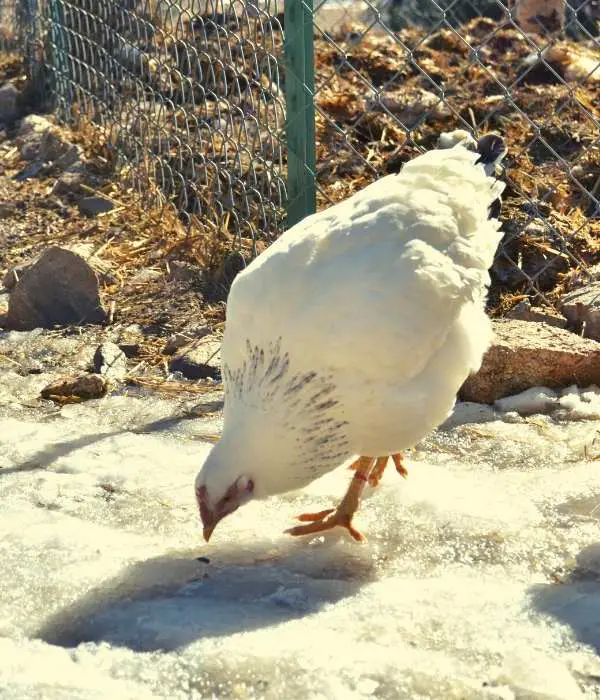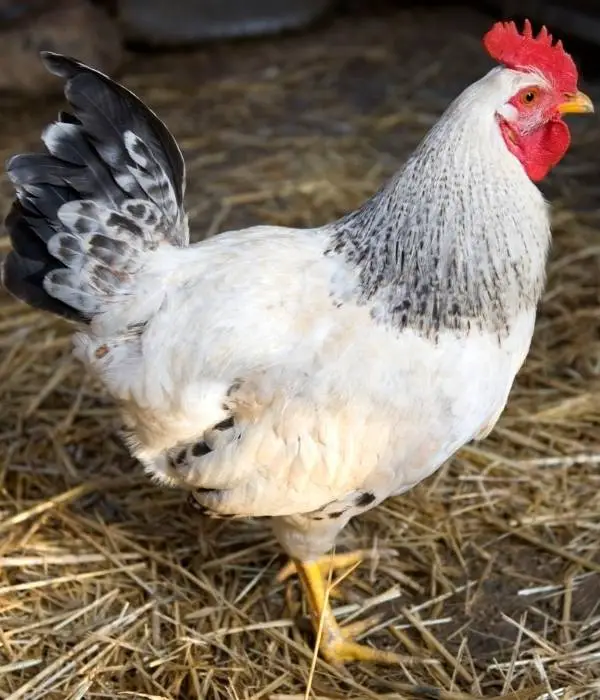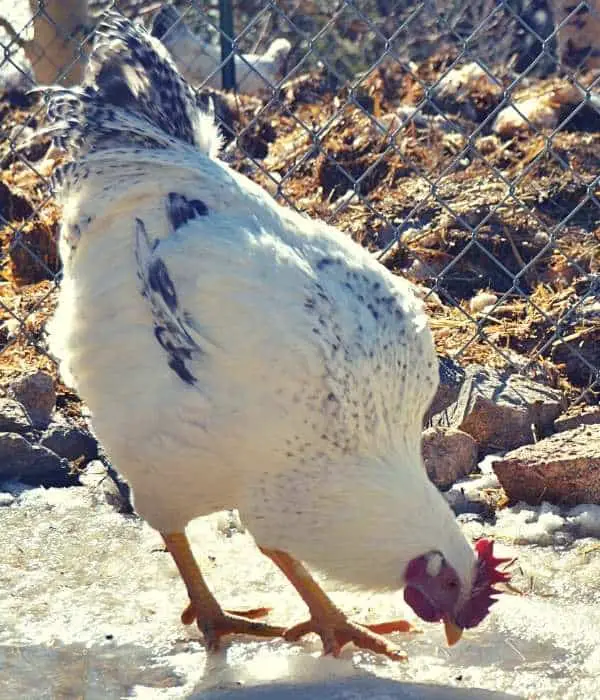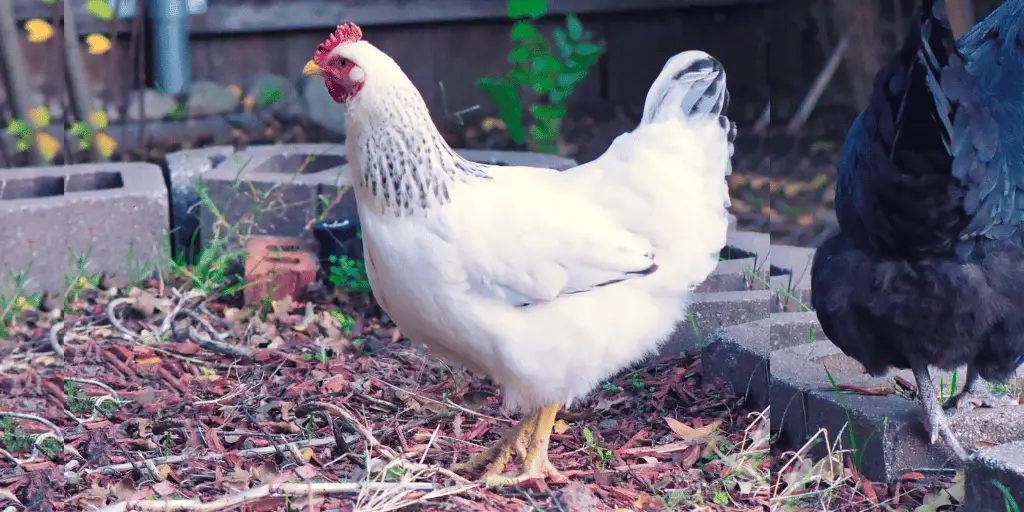The Delaware chicken breed is excellent for backyard chicken keepers and commercial poultry farmers.
This guide will introduce you to these remarkable birds’ history, characteristics, eggs, size, temperament, appearance, and care requirements.
Ultimately, you should better understand whether this breed is right for your farm or backyard flock.
Introduction to Delaware Chicken Breed
The Delaware chicken is a versatile and hardy breed well-suited for meat and egg production.
They are a good choice for people who want to raise chickens for the first time or for people who have been raising chickens for a long time and want a low-maintenance breed.
These friendly, docile birds are known for their striking appearance and high level of productivity. The Delaware breed is still considered an excellent dual-purpose bird, with rapid growth and fast feathering of chicks.
The background, physique, and temperament of Delaware chickens will be discussed in this guide, as well as their egg-laying abilities and suitability for poultry farming.
History and Origin of Delaware Chickens

The Delaware chicken breed was developed in the mid-20th century in the United States. George Ellis, a poultry farmer from Delaware, crossed Barred Plymouth Rock hens and New Hampshire roosters to create a better meat bird.
It resulted in a medium-sized, primarily white bird with good egg-laying abilities and meat production qualities.
The breed was intended to create an all-around utility bird that could be used for both egg and meat production and was developed to improve existing breeds by producing birds better suited to cold climates, more docile, and easier to handle than other chickens.
The result was the Delaware chicken, a breed that quickly gained popularity for its superior meat quality, fast growth rate, and excellent egg production.
The breed was initially called the Indian River chickens but was later renamed after the state of Delaware.
Although Delaware chickens were once the primary broiler breed in the United States, they eventually lost popularity to the faster-growing Cornish Cross.
The American Poultry Association (APA) recognized the Delaware chicken breed white variety for exhibition in 1952.
Today, the Delaware chicken is considered a rare breed, but it is still highly valued by small-scale poultry farmers and backyard chicken enthusiasts for its productivity and friendly disposition.
Lifespan of Delaware Chickens
Delaware chickens have a relatively long lifespan compared to other chicken breeds. On average, they can live from 6 to 8 years, but some may live even longer with proper care and management.
Their hardiness and adaptability make them an excellent choice for those looking for a long-lasting addition to their flock.
Delaware Chicken Color Varieties

Delaware chickens are white with black barring on their necks, wings, and tails. This unique color pattern sets them apart from other chicken breeds and makes them easily recognizable.
Only one White variety of Delaware is recognized by the APA, and they are a heritage breed with watch status. The Blue Variety is still not accepted.
Some Delaware chickens may have more black feathering than others, but the overall appearance should be predominantly white.
Physical Characteristics of Delaware Chickens
Delaware chickens are medium to large-sized birds with sturdy and well-proportioned build. They have a broad, deep chest and a moderately long back.
Their heads are relatively small, with a straight, medium-length beak and large, bright red eyes.
The comb of a Delaware chicken is a single, upright comb with five to seven points. Their wattles and earlobes are also red, contrasting nicely with their white feathering.
The legs of Delaware chickens are strong and well-spaced, with yellow skin and four toes on each foot.
Temperament and Personality Traits
Delaware chickens are known for their friendly and docile temperament. They are easily handled and get along well with other chickens and pets.
These birds are also curious and may enjoy exploring their surroundings or following their keepers around the yard.
Their calm and gentle nature makes them a good choice for families with children or people who want a more relaxed and peaceful flock.
However, while Delaware roosters are generally friendly, they can sometimes become territorial and aggressive, especially during the breeding season.
Delaware Hen Egg Production and Broodiness
Delaware chickens are excellent layers, producing large brown eggs at a rate of 4-5 eggs per week. They typically begin laying eggs around 18 to 20 weeks and can continue to lay well into their senior years.
The eggs are medium to large, weighing around 2.2 ounces (62 grams) each. Delaware hens are not particularly broody, so if you’re interested in hatching eggs, you may need to use an incubator or enlist the help of a more broody chicken breed.
Size and Weight of Delaware Chickens
Delaware chickens are medium to large birds, with roosters weighing 8-8.5 pounds (3.6-3.9 kg) and hens weighing 6-6.5 pounds (2.7-2.9 kg). Chicks usually weigh around 40-50 grams at hatching, and they grow rapidly, reaching their full size in just 16-18 weeks.
Delaware Chicken Appearance

Delaware chickens have a robust and well-proportioned body shape, with a broad, deep chest and moderately long back. Their yellow skin gives the bird a healthy and vibrant appearance.
The feathers of Delaware chickens are predominantly white, with black barring on the neck, wings, and tail. This unique color pattern makes them stand out among other chicken breeds.
Their combs are single and upright, with five to seven points, and their wattles and earlobes are bright red.
Delaware chickens have strong, well-spaced legs with yellow skin and four toes on each foot. Their appearance is striking, making them a beautiful addition to any flock.
Delaware Baby Chicks
Delaware baby chicks are adorable and fluffy, with light yellow down that will eventually be replaced by their adult feathering.
The brooder with a heat source, freshwater, and appropriate chick starter feed are required to care for.
As the chicks grow, you may notice some developing their black barring sooner than others, which can help determine their gender.
Male Delaware chicks will generally have more pronounced and darker barring than females.
Delaware Hen Vs. Rooster
Distinguishing between Delaware hens and roosters can be challenging, as their color patterns and overall appearance are quite similar. Nevertheless, there are several key differences to consider:
1. Comb and Wattles: Roosters will have larger combs and wattles than hens, and these features will develop more quickly in males.
2. Feathering: Male Delaware chickens often have more pronounced black barring on their necks and tails, while females may have more subtle barring.
3. Size: Roosters are generally larger than hens, weighing 8-8.5 pounds, while hens weigh 6-6.5 pounds.
Delaware Chicken Noise Levels
Delaware chickens are relatively quiet birds, making them suitable for urban or suburban settings where noise may be a concern.
While they naturally tend to “talk” to one another and make typical chicken sounds, their vocalizations are mostly not as loud or frequent as other breeds.
Remember that roosters will naturally crow, which can be pretty loud. If noise is a concern, consider keeping only hens or looking into a quieter rooster breed.
Delaware Chickens for Meat Production
Delaware chickens were initially developed for meat production and are still highly valued for their tender, flavorful meat.
They grow quickly, reaching their full size in just 16-18 weeks, making them an economical choice for raising chickens for meat.
Their well-proportioned bodies and yellow skin also make them attractive when processed, appealing to consumers and ideal for small-scale farmers or backyard chicken keepers who want to raise their meat birds.
Raising Delaware Chickens: Tips and Considerations

When raising Delaware chickens, several factors should be considered.
1. Space Requirements: Delaware chickens are active birds and require plenty of space to roam and forage. If you’re raising them in a backyard setting, provide adequate space for them to move around and stretch their wings.
2. Coop and Run: A secure and well-ventilated coop is essential for keeping Delaware chickens healthy and safe. Ensure to provide roosting bars, nesting boxes, and an enclosed run for them to explore during the day.
3. Diet: Delaware chickens require a balanced diet to maintain their health and productivity. Provide them with high-quality poultry feed and access to grit and fresh water.
4. Delaware chickens can be prey to predators such as raccoons, foxes, and birds of prey. Ensure their coop and run are secure, and consider installing a predator-proof fence around your property.
Health Issues in Delaware Chickens
Delaware chickens have a few health issues to watch out for but are generally healthy and hardy birds.
1. Parasites: Delaware chickens can be susceptible to common poultry parasites like lice and mites. Ensure you regularly inspect your birds and their living quarters for signs of infestation and treat them accordingly.
2. Respiratory Infections: Delawares can be prone to respiratory infections like all chickens. Maintain a clean and well-ventilated coop to minimize the risk of disease.
3. Bumblefoot: This bacterial infection can affect chickens’ feet. Keep the coop and run clean and dry to stop Bumblefoot from growing.
FAQs About Delaware Chicken
When do Delaware chickens start laying eggs?
Delaware chickens typically start laying eggs around 24 to 28 weeks, producing 4-5 large to jumbo-sized brown eggs per week, averaging around 200 to 250 eggs annually.
How long do Delaware chickens live?
On average, Delaware chickens can live from 6 to 8 years, but some may live even longer with proper care and management.
Where to buy Delaware chickens?
There are several options for buying Delaware chickens, including online hatcheries, local breeders, and agricultural expos. Make sure to buy from a reputable source and choose healthy and well-bred birds.
You can purchase Delaware chickens online from Cackle Hatchery, a trusted source since 1936. Deer Run Farm also has a line of Delaware chickens with a proven growth rate similar to the original 1940s Delaware meat birds. Additionally, Tractor Supply Co. offers live Delaware chickens for purchase, with 10 counts available.
What does a Delaware chicken look like?
Delaware chickens are medium-sized birds with deep and broad body that gives them a robust appearance. They are white with black barring on their hackles, tail, and occasionally wings and body.
Their feathering is relatively tight, and they are calm and friendly. The breed was developed by breeding Barred Plymouth Rock roosters to New Hampshire hens, and they were initially bred for egg and meat production.
They are good at laying big brown eggs and are generally healthy. They tend to get frostbite on their combs. Delaware chickens can be used to produce sex-linked chicks and are a good addition to any flock.
Why is Delaware the Blue Hens?
The Delaware Blue Hen is the official bird of the State of Delaware and serves as the emblem or mascot of several institutions in the state, including The University of Delaware. The origin of the Blue Hen dates back to the Revolutionary War.
The men of the 2nd company of the First Delaware Regiment were nicknamed after the plumage on their uniforms that resembled a fighting cock, or were said to have taken blue game chickens with them.
The blue hen chicken was designated the official state bird of Delaware in 1939, and its history as a state symbol is celebrated through various photos and videos. It’s important to note that while the Blue Hen is not a recognized chicken breed, it is a blue strain of American gamecock.
Are Delaware chickens good layers?
Yes, Delaware chickens are excellent layers of large or jumbo brown eggs. They can lay about 4 large to jumbo, light brown eggs a week, up to 200 a year.
Delaware hens are not very interested in being broody, so they focus more on laying eggs. The breed became popular in the 1940s for its use in the broiler industry but was eventually sidelined by even faster-growing breeds.
Despite their rareness, Delaware is popular among young farmers for their dual-purpose abilities, including good egg production.
How many eggs do Delaware chickens lay?
Delaware chickens lay approximately 200–250 eggs annually, about 4 per week. Each egg weighs around 2.2 ounces (62 grams).
Are Delaware chickens cold-hardy?
Delaware chickens can tolerate cold temperatures but are not recommended for cold climates. However, they may require additional heat or protection from extreme cold in some climates.
If you live in a cold climate and are looking for a cold-hardy breed, you may want to consider other breeds. A few popular cold hardy breeds are Chanteclers, Rhode Island Reds, Buckeyes, or Australorps, known for their cold tolerance and ability to lay eggs even in the winter.
When do Delaware chickens lay eggs?
Delaware chickens typically begin laying eggs around 18 to 20 weeks and can continue to lay well into their senior years.
How fast do Delaware chickens grow?
Delaware chickens are fast-growing birds that mature quickly, reaching a size large enough for harvest and egg-laying at around 3-4 months.
The different bloodlines within the breed affect maturity time and production traits, with some breeders selecting meat or egg production.
The Delaware Broiler, a slow-growth bird similar to other heritage breeds, can be butchered as early as 12 weeks but can also be raised for 2-4 weeks longer.
How much do Delaware chickens cost?
The cost of Delaware chickens can vary depending on the breeder, age, and availability. You can expect to pay between $5 and $10 per chick or $20 and $30 per adult bird.
Do Delaware chickens have feathered feet?
No, Delaware chickens do not have feathered feet. They have solid and well-spaced legs with yellow skin and four toes on each foot.
Conclusion: Is the Delaware Chicken Right for Your Farm?
The Delaware chicken may be an excellent choice for your farm or backyard flock if you want a friendly, productive, low-maintenance chicken breed. These birds are hardy, adaptable, and well-suited for meat and egg production.
While Delaware chickens are generally healthy and easy to care for, they require appropriate housing, diet, and predator protection to thrive.
Ensure they have plenty of space, clean living conditions, and a balanced diet to help them reach their full potential.
Delaware chickens will be valuable to any flock with their striking appearance, excellent productivity, and friendly temperament.


